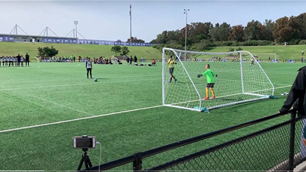Players who can slot into multiple positions are a valuable tool in the A-League… Or are they?
It’s a phrase that many A-League fans will be familiar with; a common line uttered amongst many an incumbent coach across the competition. “[Name] is such a versatile player – he can play a number of positions, and that’s really valuable to us”. Now at first listen, that’s hardly something to be argued with. Small squad sizes in the A-League means that it’s simply not feasible to stock your squad with eight centre halves in case of an injury crisis. A player who can move into a secondary position and ‘do a job’ there outside his normal role is therefore a valuable commodity.
Thing is, I’m not sure that’s always the case. Take for example the case of one Naum Sekulovski; initially he was used as a striker and scored 5 goals in 17 appearances for Perth Glory in 2005/06. But over the course of the next five years, Sekulovski was played as (from memory) an attacking mid, left mid, left wingback and left full back. The end result? A defender who, while very good on the counter-attack, struggled with positioning and picking the right tackle. He became a ‘jack of all trades, master of none’ rather than the versatile master player wanted by his coach. None of that was the fault of the player, of course – over his career he just did what he was told to do by the person who happened to be wearing the Glory coaching tracksuit at that time. But it’s hard to argue that it’s had a negative effect on his career when, after six seasons with Perth, Sekulovski found himself released and a free agent on the footballing market once again.
Elsewhere we can look to Sydney FC’s Jamie Coyne as another example of a ‘versatile’ player. Right midfielder, central midfielder, defensive midfielder, right back, centre half – he’s played it all. Yet ask the Glory faithful just how well he plays, and you’ll get a pretty emphatic answer. When Coyne was playing as a right back, he did a serviceable job. Nothing stellar, but good enough to play at A-League level (though being dropped once in a while might have actually helped him keep his focus better). In the NSL, he was a sometime right midfielder, albeit that he didn’t get nearly as much game time when compared to his A-League career. But once he was pushed around the park and asked to fill all sorts of gaps by his A-League coaches, his form went in the bin and he never really recovered. Coyne was simply stretched too far - and the roles he was asked to play seemed to do nothing but confuse the bloke. Is it really any wonder then that he too was released from his Perth contract?
Yet before we declare versatility a scourge that must be wiped from the face of Australian football, we should look at some players who have used it to their team’s advantage. First up is Jamie Harnwell – a man who wouldn’t care where you played him, as long as he was on the park. A central defender first and foremost, Ron Smith successfully converted him into a powerful striker who was deadly as a target man and continually underestimated by eastern states fans and teams alike. Part of Harnwell’s success as a striker is down to the attitude of the man himself; Jamie once voluntarily pulled on the goalkeeping gloves for the final minutes of a match as Tando Velaphi picked up a nasty injury with no subs remaining, and few other players would do that. But core to Harnwell’s successful switch forward was the fact that he had only two key positions, and the role he played in each took advantage of some of his biggest strengths. As both a target man and a central defender, Harnwell’s heading ability, strength, and positioning on the field were vitally important. Likewise, his fighting spirit and lack of fear ensured that his body was put on the line for the team time and time again, regardless of whether he was in attack or defence.
Contrast this with someone like James Robinson – in the same sort of era that saw Harnwell pushed forward, “Robnison” was turned from a striker into a central midfielder. As a forward he was known for his strong work rate, running about the place and harrying opposition defenders. The coaching staff obviously thought this could be translated into an effective midfield weapon. Unfortunately, this was not the case. Whilst his work rate was equally good in midfield, the other important attributes needed in the role – a good first touch, an eye for a pass, well timed tackling and good positioning on the field – were sorely lacking. The player became the butt of jokes among the Glory fanbase (even more so after the shirt misprint) and the ‘versatility’ described by his manager was simply useless.
With all this in mind, here’s a quick checklist for budding coaches and existing A-League managers alike when it comes to their ‘versatile’ players:
- If your player has more than two positions, chances are they’re rubbish. There are exceptions to this rule, of course – Rhys Williams is an example at a higher level – but it’s no coincidence that some of the most oft-criticised players in the A-League have pulled a shift in many, many different positions. Jobe Wheelhouse, Jamie Coyne, and Naum Sekulovski all come to mind. In some cases, they were decent enough players before a coach decided to play positional lottery with them.
- Favour players who are masters of one position, not ‘sorta kinda good’ at several. Two strapping central defenders. Quick and intelligent fullbacks. Midfielders who can pass and tackle well. Strikers who can trap a ball and shoot. The kind of things you learned at Coaching 101 still apply in the A-League. No matter what, Chris Coyne will always be a better central defender than his brother Jamie; and vice-versa when it comes to playing right back.
- If you have to push a player into a new position, at least check if they’ve got the skills needed to play there. Chances are a marauding full back can play further upfield if they naturally have good pace, dribbling, and crossing ability. But if that same defender is a bit of a skinny midget, you probably wouldn’t want to move him to central defence. It really is that simple, that logical.
Now that seems pretty straightforward, right? Unfortunately, as many fans around the country can attest, these rules aren’t always followed. Versatility is still looked at as some kind of silver bullet to all sorts of positional problems and injury crises around the country, and players continue to have their careers and reputations damaged by coaches willing to shuffle them any which way around the field. In a salary capped league with limited squad sizes, there will always be a temptation to recruit players that can be deployed into multiple roles – it’s value for money and gives greater squad depth. But this has to be balanced against the risk of confusing the player, weakening a particular area of the park, and reducing the spectacle of the game.
Therefore I put it to you, the readers, to decide. Is versatility a blessing or a curse in the A-League? And where does one draw the line?
Related Articles

Fresh talent flock to ambitious A-League outfit's pro pathway

Why A-League 20/21 is crucial for Olyroos’ medal hopes













